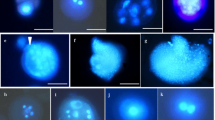Abstract
Conditions for reliable induction of embryogenesis from isolated microspores were studied in ten genotypes of broccoli. Embryo yields were significantly increased in almost all of the broccoli genotypes by the incubation at 32.5 °C for 1 day, than when the standard incubation at 30 °C for 2 days was used. Treatments of 48 hours at 32.5 °C produced less than optimal results suggesting that broccoli microspores are more sensitive to high temperatures than those of B. napus. The use of the 1/2 NLN-13 medium yielded greater number of embryos than the standard NLN-13. The magnitude of the response to the redution of the concentration of major salts by half in the NLN medium varied with the different genotypes. High embryogenic broccoli cultivars, such as ‘Shogun’, ‘SDB9’, and ‘Green Valiant’, presented a better response to the reduction of the concentration of major salts by half in NLN-13. Reduction never produced a detrimental effect on embryo yield and seems not to have any effect in the subsequent development of embryos in plants.
Similar content being viewed by others
References
Biranova, P., G. Hause, V. Cenklovà, J.H.G. Cordewener & M.M. Van Lookeren Campagne,1997. A severe heat shock is required to induce embryogenesis in late bicellular pollen of Brassica napus L. Sex Plant Reprod 10: 200–208.
Cao, M.Q., F. Charlot & C. Doré, 1990. Embryogenèse et régénération de plantesde chou à choucroute (Brassica oleracea L. ssp. capitata) par culture in vitro de microspores isolés. CR Acad Sci Paris Série III 300: 203–209.
Custers, J.B.M., J.H.G. Cordewener, Y. Nöllen, J.J.M. Dons & M.M. Van Lookeren Campagne,1994. Temperature controls both gametophytic and sporophytic development in microspore cultures of Brassica napus. Plant Cell Rep 13: 267–271.
Dias, J.S., 1999. Effect of activated charcoal on Brassica oleracea microsporeculture embryogenesis. Euphytica 108: 65–69.
Dias, J.S. & C. Correia, 2000. Effect of mediarenovation and incubation temperature regimes on tronchuda cabbage microspore culture embryogenesis. In: B. Borut (Ed.), Biotechnological Approaches for Utilization of Gametic Cells, pp. 137–145 (in press).
Duijs, J.G., R.E. Voorrips, D.L. Visser & J.B.M. Custers, 1992. Microspore culture is successful in most crop types of Brassica oleracea L. Euphytica 60: 45–55.
Farnham, M.W., 1998. Doubled-haploid broccoli production using anther culture: effectof anther source and seed set characteristics of derived lines. J Amer Hort Sci 123: 73–77.
Gland, A., R. Lichter & H.G. Schweiger, 1988. Genetic and exogenous factors affecting embryogenesis in isolated microspore cultures of Brassica napus L. J Plant Physiol 132: 613–617.
Halkjaer, M. & S. Ringgaard, 1997. MicrosporeCulture in B. oleracea L. COST-824 Gametic Embryogenesis Workshop, Book of Abstracts. Sjusjoen, Norway. p. 32.
Hansen, M. & E. Elameen, 1997. Application of Microspore Culture in Norwegian Cabbage Breeding Programme.COST-824 Gametic Embryogenesis Workshop, Book of Abstracts. Sjusjoen, Norway. p. 14.
Hoser-Krauze, J.,E. Lakowska-Rik & J. Antosik, 1987. The inheritance of broccoli (Brassica oleracea v. botrytis L.) leaf resistance to downy mildew - Peronospora parasitica (Pers.) ex Fr. Genet Pol 28: 377–380.
Lichter, R., 1981. Antherculture of Brassica napus in a liquid culture media. Z Pflanzenphysiol 103: 229–237.
McCullagh, P. & J.A. Nelder, 1989. Generalized Linear Models. Monographs on Statistics and Applied Probability 37. Chapman & Hall, London. pp. 511.
Nitsch, C. & J.P. Nitsch, 1967. The induction of flowering in vitro in stem segmentsof Plumbago indica L. I. The production of vegetative buds. Planta 72: 355–370.
Pink, D., 1999.Application of Doubled Haploid Technology and DNA Markers in Breeding for Clubroot Resistance in Brassica oleracea. COST-824 Gametic Embryogenesis Workshop, Book of Abstracts. Krakow, Poland, pp. 5–7.
Sato, T., T. Nishio & M. Hirai, 1989. Plant regeneration from isolated microspore cultures of Chinese cabbage (Brassica campestris ssp. pekinensis). Plant Cell Rep 8: 486–488.
Takahata, Y., Y. Takany & N. Kaisuma, 1993. Determinationof microspore population to obtain high frequency embryogenesis in broccoli (Brassica oleracea L.). Plant Tiss Cult Lett 10: 49–53.
Takahata, Y. & W.A. Keller, 1991. High frequency embryogenesis and plant regeneration inisolated microspore culture of Brassica oleracea L. Plant Sci 74: 235–242.
Vicente, J.G. & J.S. Dias,1996. Production of embryos from microspore cultures of Portuguese tronchuda cabbage landraces. Acta Horticulturae 407: 219–226.
Wrage, K. & S. Writer, 1994. A new era for value-added vegetables? Bringing anti-cancercompounds to the produce shelves. Seed & Crop Industry 45: 4–15.
Author information
Authors and Affiliations
Rights and permissions
About this article
Cite this article
da Silva Dias, J.C. Effect of incubation temperature regimes and culture medium on broccoli microspore culture embryogenesis. Euphytica 119, 389–394 (2001). https://doi.org/10.1023/A:1017563915319
Issue Date:
DOI: https://doi.org/10.1023/A:1017563915319




